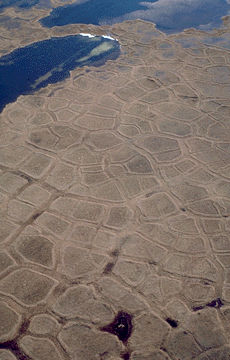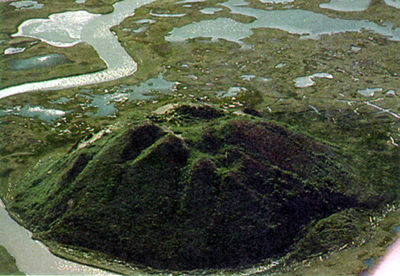Article
Peregrine Falcon
The peregrine falcon (Falco peregrinus) is a crow-sized, long-winged bird of prey, generally acknowledged to be the swiftest bird (attaining speeds of over 320 km/h).

Enter your search term
Signing up enhances your TCE experience with the ability to save items to your personal reading list, and access the interactive map.
Create AccountArticle
The peregrine falcon (Falco peregrinus) is a crow-sized, long-winged bird of prey, generally acknowledged to be the swiftest bird (attaining speeds of over 320 km/h).
"https://d3d0lqu00lnqvz.cloudfront.net/media/media/1f073f28-bd23-431b-b808-03a84178fec0.jpg" // resources/views/front/categories/view.blade.phphttps://d3d0lqu00lnqvz.cloudfront.net/media/media/1f073f28-bd23-431b-b808-03a84178fec0.jpg

Article
A periglacial landform is a feature resulting from the action of intense frost, often combined with the presence of permafrost. Periglacial landforms are restricted to areas that experience cold but essentially nonglacial climates.
"https://d3d0lqu00lnqvz.cloudfront.net/media/media/abcd7af0-a9a4-4141-9543-193539282103.jpg" // resources/views/front/categories/view.blade.phphttps://d3d0lqu00lnqvz.cloudfront.net/media/media/abcd7af0-a9a4-4141-9543-193539282103.jpg

Article
Periwinkle is a common name for any of the edible intertidal snails of the genus Littorina. Periwinkles are represented by 6 species in Canadian coastal waters.
"https://d3d0lqu00lnqvz.cloudfront.net/media/media/89a4e691-d72e-4af1-a2f2-3f608f6f525b.jpg" // resources/views/front/categories/view.blade.phphttps://d3d0lqu00lnqvz.cloudfront.net/media/media/89a4e691-d72e-4af1-a2f2-3f608f6f525b.jpg

Article
Permafrost is ground remaining at or below 0°C continuously for at least two years. About 50 per cent of Canada is underlain by permafrost, mainly in the Arctic Archipelago, Yukon, Northwest Territories and Nunavut.
"https://d3d0lqu00lnqvz.cloudfront.net/media/media/5e658751-a56e-4535-9950-f641ec565a97.jpg" // resources/views/front/categories/view.blade.phphttps://d3d0lqu00lnqvz.cloudfront.net/media/media/5e658751-a56e-4535-9950-f641ec565a97.jpg

Article
Persistent organic pollutants (POPs) are carbon-based chemical compounds or groups of chemical compounds of anthropogenic (resulting from human activities) origin that are biologically and chemically inert.
"https://www.thecanadianencyclopedia.ca/images/tce_placeholder.jpg?v=e9dca980c9bdb3aa11e832e7ea94f5d9" // resources/views/front/categories/view.blade.phphttps://www.thecanadianencyclopedia.ca/images/tce_placeholder.jpg?v=e9dca980c9bdb3aa11e832e7ea94f5d9

Article
Substances used to control pests include insecticides (for control of insects), fungicides (for disease-causing fungi), herbicides (for weeds), rodenticides (for rodents), avicides (for birds), piscicides (for fish) and nematicides (for nematodes).
"https://www.thecanadianencyclopedia.ca/images/tce_placeholder.jpg?v=e9dca980c9bdb3aa11e832e7ea94f5d9" // resources/views/front/categories/view.blade.phphttps://www.thecanadianencyclopedia.ca/images/tce_placeholder.jpg?v=e9dca980c9bdb3aa11e832e7ea94f5d9

Article
The phalarope (family Scolopacidae) is a sandpiperlike shorebird, highly specialized for aquatic life. Only 3 species are found worldwide and all occur in Canada.
"https://d3d0lqu00lnqvz.cloudfront.net/media/media/d793e666-09d5-463f-8dc8-cd470ebb9b37.jpg" // resources/views/front/categories/view.blade.phphttps://d3d0lqu00lnqvz.cloudfront.net/media/media/d793e666-09d5-463f-8dc8-cd470ebb9b37.jpg

"https://d3d0lqu00lnqvz.cloudfront.net/media/media/752356fc-d886-4733-af69-08e77cf48f2f.jpg" // resources/views/front/categories/view.blade.phphttps://d3d0lqu00lnqvz.cloudfront.net/media/media/752356fc-d886-4733-af69-08e77cf48f2f.jpg

Article
Tall, vibrantly coloured summer-flowering phlox, derived from eastern North American P. paniculata, one of the most popular garden perennials in Canada, is often used for island beds or as border plants.
"https://www.thecanadianencyclopedia.ca/images/tce_placeholder.jpg?v=e9dca980c9bdb3aa11e832e7ea94f5d9" // resources/views/front/categories/view.blade.phphttps://www.thecanadianencyclopedia.ca/images/tce_placeholder.jpg?v=e9dca980c9bdb3aa11e832e7ea94f5d9

Article
Pickerel, common name for 3 closely related carnivorous, soft-rayed freshwater fishes in the pike family (Esocidae).
"https://d3d0lqu00lnqvz.cloudfront.net/media/media/a55af02e-e819-42d4-88f3-d4a0f6aecc15.jpg" // resources/views/front/categories/view.blade.phphttps://d3d0lqu00lnqvz.cloudfront.net/media/media/a55af02e-e819-42d4-88f3-d4a0f6aecc15.jpg

Article
The pigeon (Columbidae) is a large family (303 species) of birds, many of which are called doves, distributed throughout temperate and tropical areas worldwide.
"https://d3d0lqu00lnqvz.cloudfront.net/media/media/1270f168-86fc-4799-9149-ad91baa20d48.jpg" // resources/views/front/categories/view.blade.phphttps://d3d0lqu00lnqvz.cloudfront.net/media/media/1270f168-86fc-4799-9149-ad91baa20d48.jpg

Article
Pika is a common name for the smallest members of the order Lagomorpha, which also includes rabbits and hares.
"https://d3d0lqu00lnqvz.cloudfront.net/media/media/af98ba70-1113-45b4-b37d-a949a1275270.jpg" // resources/views/front/categories/view.blade.phphttps://d3d0lqu00lnqvz.cloudfront.net/media/media/af98ba70-1113-45b4-b37d-a949a1275270.jpg

Article
Pike is the common name for the group of 5 species of predaceous freshwater fish with elongated snouts, sharp teeth, cylindrical bodies and forked tails, belonging to family Esocidae, order Esociformes, class Actinopterygii.
"https://d3d0lqu00lnqvz.cloudfront.net/media/media/b3274c7c-a583-453e-9df1-19e86cd30f1d.jpg" // resources/views/front/categories/view.blade.phphttps://d3d0lqu00lnqvz.cloudfront.net/media/media/b3274c7c-a583-453e-9df1-19e86cd30f1d.jpg

Article
Most are either "soft" pines with 5 needles per shoot or "hard" pines with 2-3 per shoot. The most familiar soft pines are western white pine (P. monticola) of BC, and eastern white pine (P. strobus), east of Manitoba. Others include limber pine (P. flexilis) and whitebark pine (P.
"https://www.thecanadianencyclopedia.ca/images/tce_placeholder.jpg?v=e9dca980c9bdb3aa11e832e7ea94f5d9" // resources/views/front/categories/view.blade.phphttps://www.thecanadianencyclopedia.ca/images/tce_placeholder.jpg?v=e9dca980c9bdb3aa11e832e7ea94f5d9

Article
A pingo is an ice-cored hill typically conical in shape, growing and persisting only in PERMAFROST. The word "pingo" is of Inuit origin and was first used in the English-language literature by the botanist Alf E.
"https://d3d0lqu00lnqvz.cloudfront.net/media/media/5e658751-a56e-4535-9950-f641ec565a97.jpg" // resources/views/front/categories/view.blade.phphttps://d3d0lqu00lnqvz.cloudfront.net/media/media/5e658751-a56e-4535-9950-f641ec565a97.jpg
